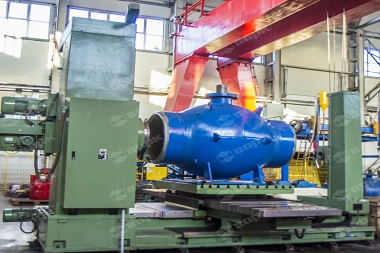Check valves are primarily used in piping systems that require an effective mechanism to prevent reverse flow. The main objective is to achieve a valve and piping system that perfectly aligns with the longest life service at the lowest cost. Accomplishing the goals requires the expertise to implement several considerations to ensure the system's efficiency.
As Indonesia's leading check valve suppliers, Oilway understands the importance of pairing the right valve with the right piping system. Our guidelines will help understand the concept and implement the right principles to choose the perfect check valve.
Before we delve into further details, we need to understand the piping system in industrial facilities.

Industrial piping systems are a far cry from domestic pipelines. These heavy-duty pipes are installed to carry a wide range of media such as chemicals, acids, gases, slurries, steam, air, wastewater, freshwater, sewage, and even juices, sauces, etc. Most industrial pipelines are large in diameter to accommodate the volume.
Also Read : Know About Check Valve Their Types & Applications
Industrial pipeline works optimally on three basic principles:
The above-mentioned principles combined with good engineering practices will ensure a faultless pipeline system with minimal need for maintenance and maximum efficiency. However, there are a few more factors that ought to be kept in mind while installing check valves for industrial pipelines.
Check valves should not be crammed in tight spaces. As per the first principle for pipeline installation, there should be two straight pipes on either side of the valve. The valve itself should be at a distance from other pipeline components such as pumps, elbows, joints, and any other component that causes turbulence strong enough to affect the function of the check valve. Ball check valves and axial flow check valves can be installed close to the inlet of an isolating valve.
The flow and size of the pipe will work in tandem only if the size is the right size for the flow volume. There must be enough pressure to allow the valve to open fully under any condition-whether minimum, normal, or maximum. This can be achieved only if the sizing calculations are right.
Vertical pipelines are installed only if they are absolutely necessary. Swing check valves are not ideal for vertical pipelines, as they lead to water hammer occurrences. Axial flow check valves are suitable because they have a strong spring that ensures instantaneous closure of the disc before the reverse flow happens, thus avoiding the water hammer.
Where valves and pipelines are concerned, one cannot afford to make mistakes. One careless slip can turn out to be a costly catastrophe, ending in unforeseen mishaps. To choose the right check valves, there are two factors to consider:
The size of the valve determines the amount of differential pressure that will be created to keep the valve open. Sufficient pressure cannot be expected if the valve is too small or too large. It is important to note the minimum, maximum and normal flow pressures to select the right valve size for the pipelines.
Valve material has to match two requirements- the pipeline characteristics and the application requirements such as temperature, corrosiveness, and pressure. The valves body material should match the pipeline's flange material.
Industrial valve manufacturers offer a wide range of valves to suit various pipeline requirements as they differ with every industrial application. Some of the most commonly used valves include:
They have a stem, disc, ball, or diaphragm to prevent the reverse flow of media.
They are quarter turn valves with a ball inside the valve's body. When the valve is turned on, the ball aligns with the inlet and outlet to facilitate the flow.
They are used for media that contain solids because they can exhibit precise flow control.
These type of valves have bolts to secure the connection and a gasket to seal the joint.
They regulate the flow with a disk that moves in relativity to the stationary ring seat.
They are shut off and on valves that allow the complete flow of media.
They use a tapered control mechanism for finer flow control.
They prevent the excessive build up of pressure in the system.
At Oilway, we manufacture and supply a wide range of high precision industrial valves suitable for all kinds of industrial pipeline designs. We also specialise in customising your valve requirements with our expertise spanning more than a decade of experience in the valve industry.
Get expert guidance from our team, who will help you choose the right valves for your industrial pipeline designs. Talk to us @+86-21-69891289.

